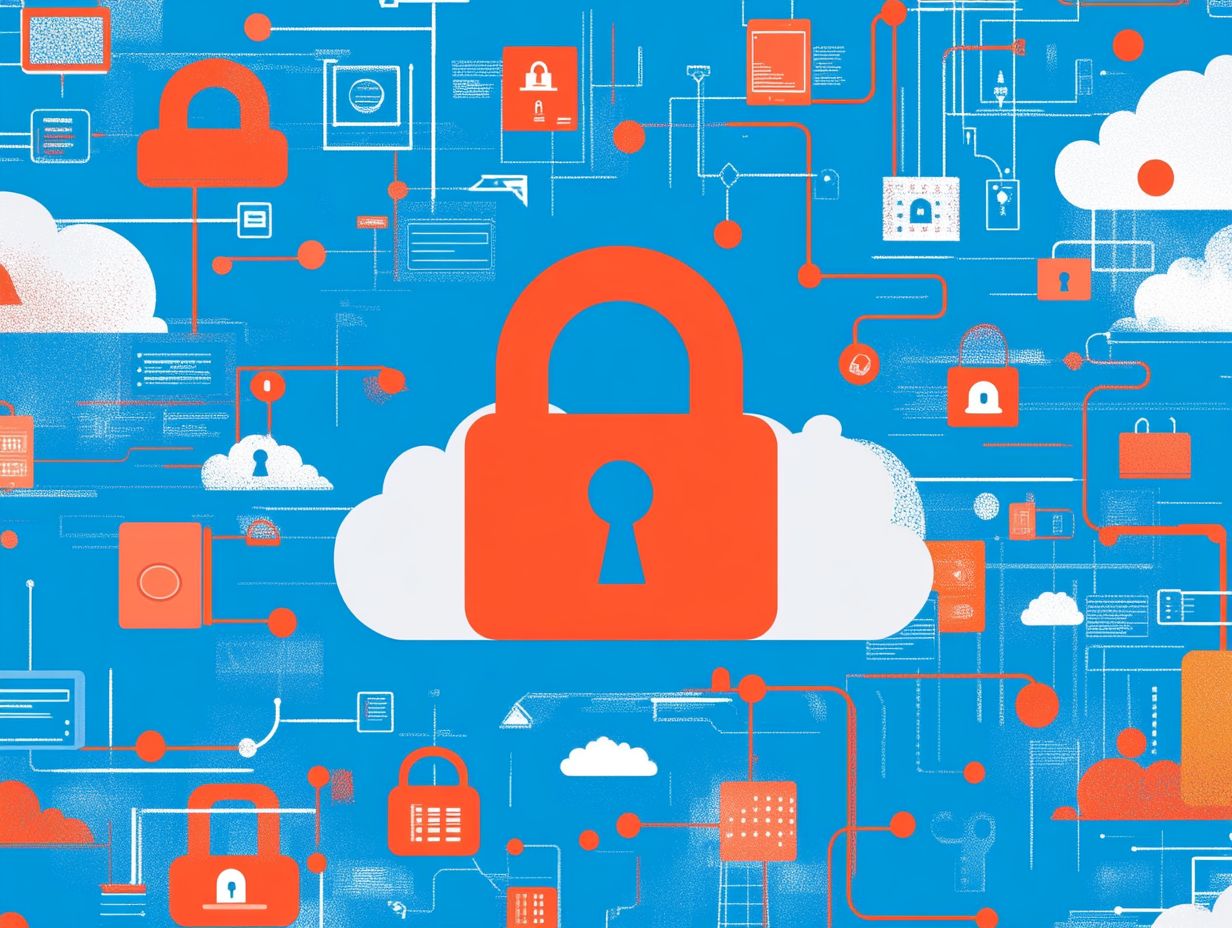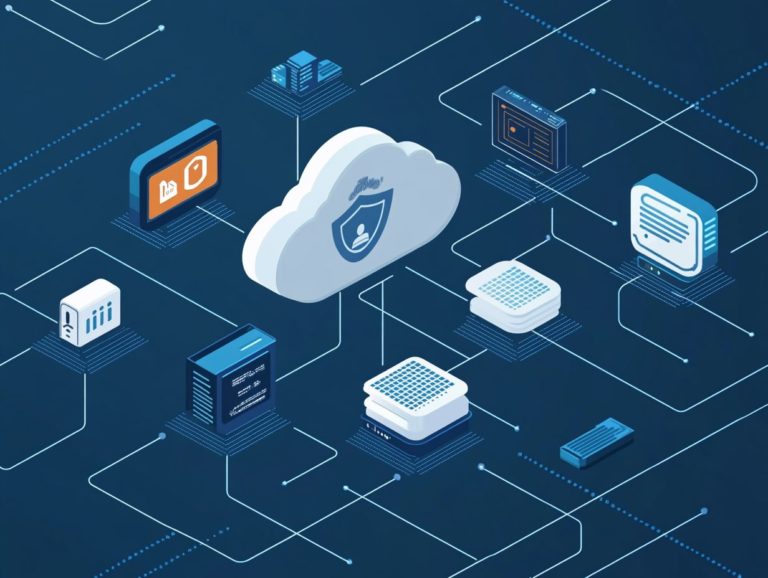Top 10 Cloud Security Tools for 2024
In an era where digital transformation is revolutionizing businesses, ensuring robust cloud security is more critical than ever.
As cyber threats continue to evolve, you must leverage the right tools to safeguard sensitive data and maintain compliance.
This article delves into the top 10 cloud security tools for 2024. Discover why these tools are essential for your cloud security now!
We will cover everything from encryption and identity management to advanced intrusion detection systems. You ll explore the importance of these tools, key features to consider, and how to select the best solutions tailored to your unique needs.
Dive in and discover how to strengthen your cloud security landscape effectively.
Contents
- Key Takeaways:
- 1. Encryption Tools
- 2. Identity and Access Management Tools
- 3. Intrusion Detection and Prevention Systems
- 4. Data Loss Prevention (DLP) Tools
- 5. Security Information and Event Management (SIEM) Tools
- 6. Vulnerability Assessment and Management Tools
- 7. Web Application Firewalls (WAFs)
- 8. Network Security Tools
- 9. Cloud Access Security Brokers (CASBs)
- 10. Multi-Factor Authentication (MFA) Tools
- What Is Cloud Security and Why Is It Important?
- What Are the Top Threats to Cloud Security?
- How Can These Tools Help Mitigate Cloud Security Risks?
- What Are the Key Features to Look for in a Cloud Security Tool?
- How Can Businesses Choose the Right Cloud Security Tools for Their Needs?
- What Are the Future Trends in Cloud Security and How Will These Tools Evolve?
- Frequently Asked Questions
- What are the top 10 cloud security tools for 2024?
- What is Cloudflare?
- How does Microsoft Azure enhance cloud security?
- Can Amazon Web Services (AWS) be used for cloud security?
- What is Symantec Cloud Workload Protection?
- How does Palo Alto Networks Prisma Cloud help with cloud security?
- Is Cisco Cloudlock a suitable cloud security tool for large enterprises?
Key Takeaways:

Strong encryption tools are essential for protecting sensitive data on the cloud.
Tools for managing who can access your cloud resources play a crucial role in preventing unauthorized access.
Intrusion detection and prevention systems, along with data loss prevention tools, help detect and prevent cyber attacks and data breaches in the cloud.
1. Encryption Tools
Encryption tools are essential to your cloud security strategy. They safeguard sensitive information from unauthorized access, ensuring robust data protection through advanced encryption techniques.
These measures are critical for compliance with security regulations and defending your digital assets against potential data breaches.
You ll encounter various encryption methods, from symmetric encryption using the same key for both encryption and decryption to asymmetric encryption, which relies on a pair of keys for secure data transmission.
Leading companies like Cloudflare, AWS, and Azure provide a range of encryption services designed specifically for their cloud infrastructures. This ensures your data remains secure both at rest and in transit.
For example, AWS offers server-side encryption for its storage services, while Azure provides comprehensive encryption capabilities for virtual machines and databases.
To maximize your security, consider implementing best practices such as:
- Regularly updating encryption keys
- Applying stringent access controls
- Performing regular audits to maintain compliance and data integrity
2. Identity and Access Management Tools
Identity and Access Management tools are essential for establishing robust access control measures in cloud environments. They enable you to manage user access, enforce security protocols, and implement multi-factor authentication.
These tools help automate user onboarding and offboarding processes while keeping accurate access records.
Access control lists define user permissions, ensuring individuals have access only to the resources necessary for their roles. This approach is crucial for safeguarding sensitive data.
Privileged access management is a cornerstone of these systems, allowing you to restrict and monitor access for high-level users. With thorough auditing capabilities, these tools enable tracking of access patterns and detection of anomalies.
3. Intrusion Detection and Prevention Systems
Intrusion Detection and Prevention Systems act as your first line of defense in cloud security. They offer continuous monitoring and threat detection, allowing you to swiftly identify and respond to potential security breaches.
Understanding the distinction between intrusion detection and prevention highlights the critical role these systems play in maintaining robust security. Intrusion detection focuses on identifying suspicious activities and alerting your security team. In contrast, intrusion prevention actively blocks these threats from compromising your system.
Consider solutions like Snort and Suricata for effective detection capabilities. Advanced tools, such as Cisco s Firepower, not only detect but also prevent attacks in real-time.
Integrating these systems into your incident management framework enhances your security analytics. This allows you to analyze trends and respond promptly to emerging vulnerabilities.
Start securing your cloud now! Explore these top tools and protect your digital assets today.
4. Data Loss Prevention (DLP) Tools
Data Loss Prevention (DLP) tools are essential for safeguarding sensitive information in cloud environments. They implement security measures that protect data integrity and prevent unauthorized access to critical assets, ensuring compliance with regulations to mitigate security vulnerabilities.
These tools utilize a blend of strategies, including data encryption, access controls, and real-time monitoring, to oversee the flow of sensitive data across networks. By leveraging advanced algorithms and machine learning, DLP solutions can effectively identify and classify data, helping you pinpoint vulnerabilities.
For example, a financial institution deploying a DLP system to monitor transactions can flag unusual activity that might signal a data breach.
To ensure successful deployment, follow these best practices:
- Define clear policies
- Train employees thoroughly
- Regularly update the system to respond to emerging threats
This multifaceted approach is crucial for maintaining security and regulatory compliance, essential for avoiding hefty fines and protecting your organization s image.
5. Security Information and Event Management (SIEM) Tools
Security Information and Event Management (SIEM) tools are vital for enhancing your security monitoring capabilities in cloud environments. They aggregate and analyze security events, providing invaluable threat intelligence that allows you to swiftly identify and manage security incidents while ensuring compliance assessments are accurate.
These tools alert you to potential threats, employing advanced analytics to sift through extensive log data and highlight anomalies that might signal security breaches. By integrating seamlessly with various security solutions, such as firewalls and intrusion detection systems, SIEM technology cultivates a robust security posture.
This collaboration not only improves detection and response times but also aids in meeting regulatory requirements by generating detailed reports essential for audits. Maintain a proactive approach in your security strategies to ensure your organization stays a step ahead.
6. Vulnerability Assessment and Management Tools

Vulnerability Assessment and Management tools are essential for identifying and mitigating security vulnerabilities within your cloud infrastructure. They enable the implementation of effective risk management practices and critical updates, strengthening your security posture against evolving cyber threats.
The vulnerability assessment process begins with thorough scanning to uncover potential weaknesses, utilizing automated tools to cover a broad range of assets.
Once you ve identified these vulnerabilities, prioritization is key; evaluate the risks based on severity and potential impact on operations. Establish effective remediation strategies now to tackle critical issues swiftly, ensuring your mitigation efforts are timely and proportionate to the risks you face.
Adopting best practices includes conducting regular assessments and maintaining continuous monitoring, fostering a proactive security environment that adapts to emerging threats. This ongoing vigilance is vital for maintaining robust defenses and ensuring compliance with industry standards.
7. Web Application Firewalls (WAFs)
Web Application Firewalls (WAFs) are crucial for protecting your cloud applications against various online threats, including Distributed Denial of Service (DDoS) attacks and SQL injection attempts. They effectively close security gaps and enforce stringent protocols, protecting your web applications vigorously.
These robust security solutions filter traffic, allowing only legitimate requests while expertly blocking malicious ones. By analyzing both incoming and outgoing data, WAFs can detect and mitigate complex threats in real time, significantly reducing potential damage to your systems.
They also help you meet compliance standards, such as PCI DSS, by offering essential logging and reporting functionalities. Notable WAF solutions include:
- AWS WAF
- Cloudflare WAF
- F5 Advanced WAF
Each of these solutions has unique features tailored to various organizational needs, helping you find the right fit for your security requirements.
8. Network Security Tools
Network Security Tools are vital to create a secure cloud infrastructure. They provide security monitoring and threat detection capabilities that help protect against vulnerabilities and ensure compliance with critical security protocols.
These tools provide a variety of powerful features, including firewalls, intrusion detection systems (IDS), and antivirus software, each tailored to address specific security needs.
For example, firewalls serve as protective barriers between trusted and untrusted networks. They significantly reduce the risk of unauthorized access. Meanwhile, IDS plays a crucial role in identifying potential threats by analyzing network traffic meticulously.
You can enhance your security posture by using tools like Security Information and Event Management (SIEM) solutions. SIEM helps you collect and analyze security data in real-time, facilitating rapid incident response.
By embracing best practices such as regular updates, continuous monitoring, and employee training, you can amplify the effectiveness of these security tools. This ensures a formidable defense against the ever-evolving cyber threats lurking in cloud environments.
9. Cloud Access Security Brokers (CASBs)
Cloud Access Security Brokers (CASBs) are essential for enhancing your data protection and ensuring compliance in cloud environments. They act as intermediaries, enforcing security protocols, managing user access, and providing visibility into cloud application usage. This facilitates effective risk management.
These solutions bridge the gap between your on-premise infrastructure and the cloud services you use. They offer the insights necessary to monitor and control data flows with precision.
By ensuring adherence to relevant regulations and policies, CASBs help mitigate the risks associated with data breaches. This is particularly important in hybrid and multi-cloud environments where sensitive information can be spread across multiple platforms.
Their robust security analytics capabilities enable you to identify potential threats in real-time. This allows you to respond proactively and minimize vulnerabilities, thereby safeguarding customer data.
As your organization increasingly embraces cloud solutions, these brokers are now essential for maintaining both trust and security.
10. Multi-Factor Authentication (MFA) Tools
Multi-Factor Authentication (MFA) tools are critical for elevating your security measures. By requiring multiple forms of verification, these tools significantly enhance access control and reduce the risk of unauthorized access.
You have several options at your disposal. For instance, you can implement:
- SMS-based codes that send a one-time passcode straight to your mobile device.
- Authentication apps that generate time-sensitive codes, providing an extra layer of security.
- Biometric verification methods, such as fingerprint or facial recognition, offer a seamless yet powerful way to confirm identity.
These diverse MFA approaches are vital for preventing breaches and crucial for meeting compliance standards. They ensure that your sensitive data remains protected in our ever-evolving digital landscape.
What Is Cloud Security and Why Is It Important?
Cloud security involves a set of tools and methods designed to protect your cloud environments and data from potential threats. This ensures that your data remains secure, compliant with regulations, and protected against unauthorized access and breaches essential for maintaining business continuity.
As more organizations transition operations to the cloud, the significance of robust security measures is paramount. Cloud service providers offer crucial solutions such as encryption, identity and access management, and continuous monitoring to help mitigate risks.
Recent statistics reveal that over 60% of companies faced a data breach in the past year, underscoring the urgent need for effective cloud security practices. Implementing tools like firewalls, intrusion detection systems, and multi-factor authentication is vital for establishing a secure cloud environment, fostering trust, and protecting your valuable assets in the digital landscape.
Start using these tools today to ensure your cloud environment is secure!
What Are the Top Threats to Cloud Security?

The top threats to cloud security include cyber risks that can lead to major incidents. These can result in data breaches and unauthorized access.
Insider threats present a unique challenge. They can arise from current or former employees who misuse their access privileges, whether intentionally or inadvertently.
Malware attacks can infiltrate cloud environments, potentially leading to severe consequences such as data loss or system downtime. Be aware of the risk posed by DDoS attacks, which flood your systems with traffic, causing them to slow down or go offline.
Each of these threats carries significant implications, including financial losses and reputational damage. This underscores the need for thorough risk assessments and proactive strategies to protect sensitive information.
How Can These Tools Help Mitigate Cloud Security Risks?
Implementing advanced security tools is essential to effectively mitigate cloud security risks. These tools enhance data protection, ensure compliance with regulations, and help manage security incidents through proactive threat detection and response capabilities.
By integrating tools like Data Loss Prevention (DLP), Identity and Access Management (IAM), and Security Information and Event Management (SIEM), you can establish a strong defense strategy.
- DLP protects against unauthorized data access by monitoring sensitive information to keep it within your organization s ecosystem.
- IAM streamlines user access, ensuring that only authorized personnel can enter critical systems.
- SIEM aggregates and analyzes security events in real-time, enabling swift identification of potential threats.
Together, these tools form a layered security framework that identifies and mitigates risks, offering a comprehensive approach to safeguarding sensitive data.
What Are the Key Features to Look for in a Cloud Security Tool?
When selecting a cloud security tool, emphasize key features such as robust threat detection, comprehensive data protection measures, and adherence to compliance regulations. These features are essential to building a strong defense against evolving threats.
Scalability is crucial too; it allows the security solution to adapt and grow with your organization s needs without sacrificing performance. Ease of integration is also important; seamless compatibility with existing systems facilitates smooth implementation.
A user-friendly interface enhances accessibility, making it easier for teams to monitor security events and respond promptly. Support for automated compliance enables effective management of regulatory requirements, reducing the risk of human error during audits.
Implementing these tools and features will significantly enhance your cloud security.
How Can Businesses Choose the Right Cloud Security Tools for Their Needs?
Finding the right cloud security tools can make all the difference for your business! It requires a thorough assessment of your specific needs. Focus on keeping your information safe, ensuring security compliance, and understanding potential dangers that align with your operational requirements and business continuity objectives.
To effectively kick off this evaluation, start with comprehensive risk assessments to identify potential vulnerabilities unique to your operations. This involves evaluating your current data storage practices, access controls, and any potential points of attack.
Next, understand and integrate the compliance requirements specific to your industry. Doing so ensures that any solutions you choose are both effective and aligned with legal mandates.
Analyze the threat landscape to prioritize your security measures. Keep an eye on emerging threats and trends in cyber incidents.
When comparing different security solutions, take the time to explore features, scalability, customer support, and integration capabilities. This way, you can ensure that the tools you select not only secure your cloud environment but also support your growth objectives.
What Are the Future Trends in Cloud Security and How Will These Tools Evolve?
The future of cloud security is on the brink of a remarkable transformation. Trends like increased automation, enhanced threat intelligence, and improved user access management are reshaping security tools. These innovations enable you to effectively counter emerging cyber threats and address vulnerabilities.
As you navigate the shift toward cloud-based infrastructures, the need for robust security measures becomes absolutely critical. The integration of artificial intelligence and machine learning into your security frameworks will be instrumental in identifying threats before they escalate.
Automating compliance processes streamlines your adherence to regulations. It also ensures that your security practices adapt in real-time to the ever-changing digital landscape. By anticipating the increasingly sophisticated nature of cyberattacks, these innovative solutions offer a proactive defense, enabling you to protect your data integrity and maintain user trust in a rapidly evolving technological world.
Frequently Asked Questions
Here are some common questions about cloud security tools:
What are the top 10 cloud security tools for 2024?

The top 10 cloud security tools for 2024 are:
- Cloudflare
- Microsoft Azure
- Amazon Web Services (AWS)
- Google Cloud Platform (GCP)
- Symantec Cloud Workload Protection
- McAfee Cloud Security
- Cisco Cloudlock
- IBM Cloud Pak for Security
- Palo Alto Networks Prisma Cloud
- CloudTrail by Amazon
What is Cloudflare?
Cloudflare is a web performance and security company that provides a content delivery network, DDoS mitigation, and internet security services.
How does Microsoft Azure enhance cloud security?
Microsoft Azure offers a range of security services, such as identity and access management, threat protection, and data encryption to enhance cloud security. It also has built-in compliance and governance features for regulatory compliance.
Can Amazon Web Services (AWS) be used for cloud security?
Yes, AWS offers a variety of security tools and services, including firewall, encryption, threat detection, and access control, to help protect your cloud infrastructure and applications.
What is Symantec Cloud Workload Protection?
Symantec Cloud Workload Protection is a security tool that provides real-time protection for workloads running in public and private cloud environments. It offers features such as intrusion prevention, network security, and compliance monitoring.
How does Palo Alto Networks Prisma Cloud help with cloud security?
Palo Alto Networks Prisma Cloud is a comprehensive cloud security platform that provides visibility, compliance monitoring, and threat detection across multiple cloud environments. It also offers automated remediation for security issues and integrates with DevOps processes.
Is Cisco Cloudlock a suitable cloud security tool for large enterprises?
Yes, Cisco Cloudlock is designed for large enterprises and offers cloud security solutions for applications, data, and users across multiple cloud environments. It has advanced threat intelligence and machine learning capabilities for enhanced security.






